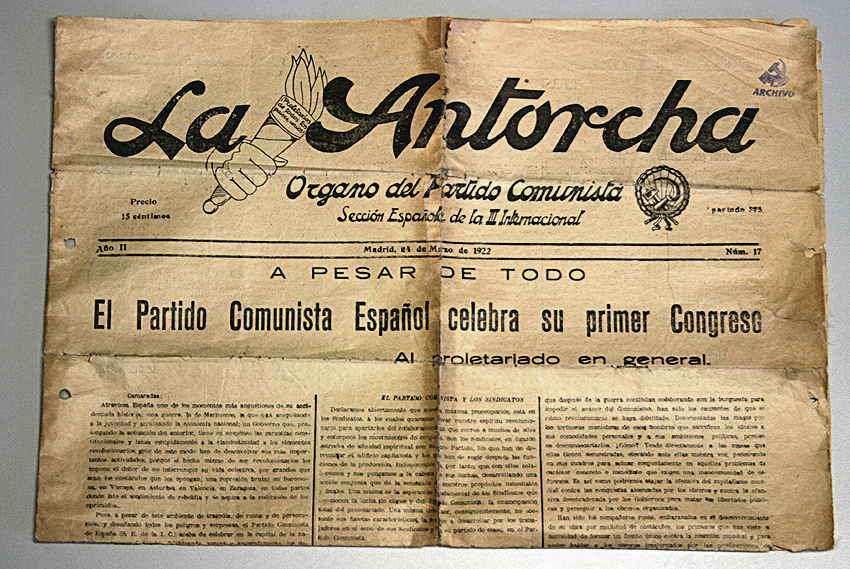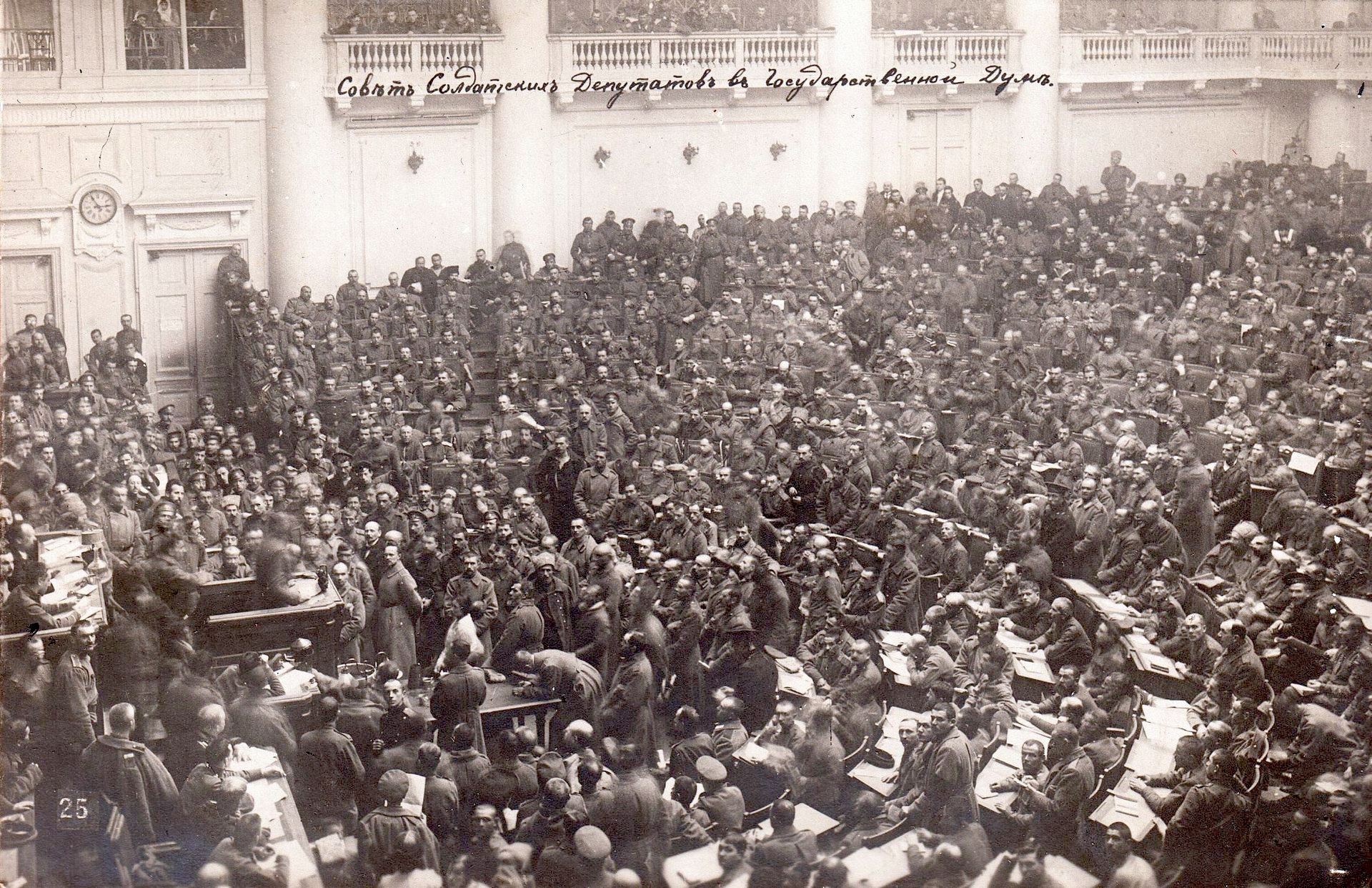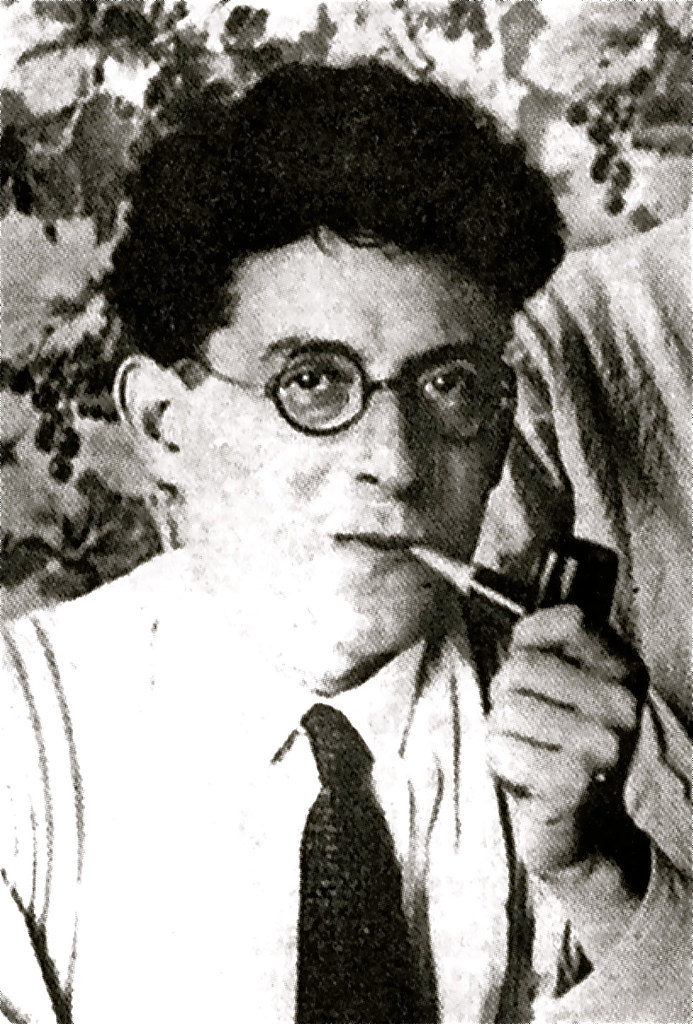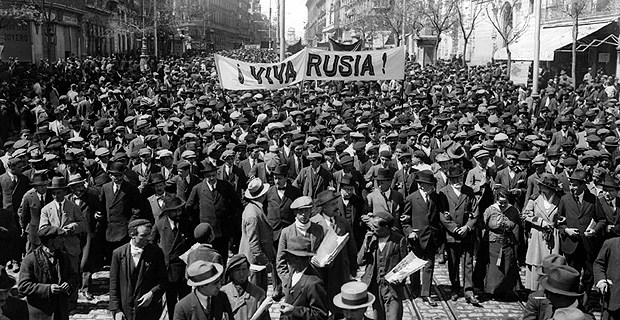This article forms part of a larger one – originally in Spanish – entitled “The Russian Revolution in Spain and the birth of Spanish Communism, 1917-21”, available on www.luchadeclases.org by Arturo Rodríguez, researcher and associate lecturer at the Universitat de Barcelona.
The Russian Revolution was a momentous event in world history, whose effects were felt in the far corners of the Earth. The victory of the Russian proletariat gave a stimulus to the class struggle on a global scale. The C.I. – or Third International – founded by the Bolsheviks in March 1919, transformed the hopes awakened by the Russian Revolution, into an organisation and a programme.
It's no surprise that in under-developed, Restoration Spain, the Russian Revolution had an especially intense impact. The years 1917-20, known as the “Bolshevik Years”, witnessed an unprecedented revolutionary ferment. In August 1917, a revolutionary general strike shook the rotten Bourbon dynasty. In January 1918, women-led mass movements against the high cost of living. In Autumn 1918, the Andalucian peasants led uprisings for land seizures and freedom. In Spring 1919 in Barcelona, a strike in the hydroelectric company La Canadiense caused a revolutionary situation, followed by a revolutionary social and economic upsurge throughout Spain.
October 1917 wasn't only a potent spur for the workers – the founding of the C.I. produced lasting transformations in the workers' movements, shaking them from top to bottom. However, in spite of the unprecedented intensity of the class struggle of those years, and the enthusiasm awoken by the Bolsheviks and the revolutionary events, it's ironic that the Bourbons, for some years, could avoid the fate of the Romanovs, Hohenzollerns and Habsburgs. In 1921, the tide turned, and reaction regrouped and went on the offensive. It launched a wave of repression that culminated in a coup by General Primo de Rivera in 1923. For their part, the Spanish communists proved incapable of capitalising on the generalised sympathy for Soviet Russia and the Third International and so the PCE was born as a meagre and divided force.
The PSOE (Spanish Socialist Party – Social Democratic) and the C.I.
In November 1917, the PSOE was demoralised by the defeat of the August general strike. Reformist currents within the party had been strengthened so, unsurprisingly, the socialist leadership reacted to October 1917 with cynicism, as if it were a nuisance. Pablo Iglesias referred to the Soviet seizure of power as “inopportune”. However, among the rank-and-file of the party and the UGT (the socialist trade union), enthusiasm spread rapidly. With the declaration of the Third Communist International, PSOE leaders tried to slow and limit the affiliation debate, making constant manoeuvres against those favourable to the Third International (terceristas). However, the radicalisation of the rank and file was such that the leadership had to make notable concessions. By Summer 1919, the question of the C.I. became the central issue of all congresses and debates.
The unquestionable bulwark of the terceristas was in the Federation of Socialist Youths (JJSS). These youths showed a sectarianism and an intransigence that placed them in the camp of what Lenin called ultra-leftism; such currents proliferated all over Europe in those years that were strident defenders of the Russian events. However, they were incapable of articulating a clear programme and, most importantly, linking it to the immediate demands of the workers in order to spread it in the mass organisations.
 The first paper published by the Communist Party of Spain (PCE) / Image: PCE Archives
The first paper published by the Communist Party of Spain (PCE) / Image: PCE Archives
Fearful of provoking the militants, the reformist leaders of PSOE tried to bureaucratically prevent debate about the Russian events. In Autumn 1919, the right wing desisted in their open opposition to the C.I., as the intense pressure from the ranks made it impossible. Instead, their slogan was for the unity of the Second and Third Internationals. In the extraordinary Congress of December, PSOE decided to provisionally stay in the Second International and call for it to merge with the Third. This was just an illusory posture borne from cynical calculation of the right wing to buy themselves time.
Reformist manoeuvres were unexpectedly reinforced by the disastrous work of Mikhail Borodin: the first delegate to Spain from the Third International. Although Borodin was an old Bolshevik, forged in the 1905 revolution, his long exile in the USA drew him closer to Menshevism. The October Revolution in 1917 made him revise his outlook, backing Lenin, and making missions in Mexico and USA. But his impatience to impress his Russian comrades and the concealment of his objections led him to unduly exploit his authority. His behaviour caused premature splits and political deviations in Mexico and Spain. It's no surprise that he ended up as a Stalinist henchman.
He went from Mexico to Spain in December 1919. In Madrid, the Bolshevik delegate despaired over the delays of the main tercerista group that was correctly reluctant to split the PSOE before having tried win it over to the Third. Anxious to leave, Borodin based himself on the ultra-lefts of the JJSS, to create the Communist Party, using a “coup d’état”. The JJSS executive simply changed their name in April 1920 to the Communist Party of Spain, PCE, informing the rank and file afterwards. Many youths, indignant with the manoeuvre, left the JJSS. Of 7,000 members of JJSS, the PCE only kept 2,000. This split, which appeared to have Moscow's backing, discredited the C.I. in the eyes of many socialist militants. The tiny PCE also maintained an extremely hostile and arrogant attitude to the CNT (the anarcho-syndicalist trade union).
Still, the prestige of the Russian Revolution was such that the terceristas in PSOE could continue work after the unfortunate split. At the June 1920 Congress, PSOE resolved to provisionally affiliate to the Third. The reformist leadership stuck to the provisional character of the affiliation with an eye to overturning it later. The Congress decided to send two delegates to Russia to discuss with Soviet leaders. Fernando de los Rios (a humanist teacher, distanced from Marxism by his petty-bourgeois social condition) and Daniel Anguiano (a railway worker and trade union leader, favourable to the Third International). Predictably, de los Rios returned scandalised by the difficult situation there, whilst Anguiano was impressed by the republic and the ideas of the C.I. So, on their return, both factions became embroiled in a fresh dispute. In Spring 1921, the enthusiasm for the Russian Revolution in the socialist press had diminished. Anti-communist propaganda had dented it and the PCE's excesses contributed to the C.I.'s discrediting. In April, the leadership rescinded their affiliation.
The left wing decided to split away, forming the Workers Communist Party of Spain (PCOE) in April 1921, with some 9,000 members and a notable presence in the UGT. However, their leaders carried over a lot of routinism from the old PSOE, centring PCOE’s focus in electoral activity and consolidating their union positions. PCOE was the opposite of PCE; if PCE sinned in extremism, PCOE sinned in sluggishness. Neither of the two currents of communism knew how to find the necessary balance. The C.I. of Lenin and Trotsky was a fantastic school to educate unsure and unbalanced communist movements, like those in Spain, but its rapid degeneration under Stalinist influence would destroy this road to salvation.
At the insistence of the C.I, in November 1921, the two groups fused into one, the PCE. Tensions between the two halves of the new PCE remained for years. The two factions had lost the bulk of their members and the new PCE had only about 1,200 members.
The CNT and the C.I.
If the Russian Revolution shook all socialist movements, its impact in the CNT was greater still. The anarcho-syndicalists became firm and honest defenders of the October Revolution and until 1921, carried the flag of Bolshevism in Spain. The extraordinary growth of the CNT in these years was related to its ability to link the situation in Spain with the events of the Russian Revolution. The CNT grew from 30,000 members in 1914, to 80,541 in September 1918, and 790,948 in December 1919.
The highpoint of CNT enthusiasm was December 1919, during its second national Congress, in the Comedy Theatre, Madrid. The CNT declared solidarity with the Russian Revolution, its opposition to whatever government attempt to aid the White armies, and affiliated to the C.I. A report backed a “transitory proletarian dictatorship to assure the revolution's victory.” This led to a heated debate, after which an agreed resolution was approved for provisional affiliation to the C.I, and it re-affirmed that the CNT objective was “libertarian communism.”
How was this nearing of postures between anarcho-syndicalists and Bolsheviks possible? Without doubt, disinformation aided the CNT to idealise the Russian Revolution. However, it’s certain that the Spanish anarchists quickly understood that the revolution was led by Marxists, and that, instead of destroying the state, the Bolsheviks had created a new revolutionary government, to unleash a fight against reaction. The CNT backed this government, which signified a highpoint of lucidity among Spanish anarchism. Experience was teaching the anarchists that the road to communism was more complicated than they'd imagined. In the light of hard repression after the strike of 1917 in Spain, and of the imperialist offensive, which the Soviets had to confront from the start, many anarcho-syndicalists concluded that a proletarian dictatorship was needed, based on workers’ and peasants’ councils, to defend the revolutionary gains.
 The anarcho-syndicalists of the CNT were initially impressed with the Bolshevik Revolution and became its most consistent defenders until 1921 / Image: public domain
The anarcho-syndicalists of the CNT were initially impressed with the Bolshevik Revolution and became its most consistent defenders until 1921 / Image: public domain
In accordance with the Comedy Theatre Congress, the CNT sent three delegates to the second Congress of the C.I. in July. Although only one of them, Angel Pestaña, would get to the country. He arrived in a country devastated and exhausted after three years of world war and three years of civil war, yet the revolution held. Pestaña visited Petrograd and Moscow for the Congress, as well as the Volga. He participated in preliminary meetings of the formation of the International Red Union (IRU): the union front of the Third International.
Pestaña came to be known as one of the most implacable opponents of the Bolsheviks. However, his trip remains shrouded in mystery, as he delayed publishing his criticisms (which were very negative) until 18 months after his visit, in March 1922. The most probable scenario is that this veteran anarchist returned with contradictory ideas, both attracted to and repelled by the situation. His reports were important in defining the position of anarcho-syndicalist militants. The late publication and enduring CNT enthusiasm for Soviet Russia meant that the CNT continued participating in the C.I. in 1921.
In Barcelona, April 1921, the CNT held a national plenary to elect a delegation for the founding congress of the IRU. Andrés Nin, Joaquin Maurín, Hilario Arlandis and Jesús Ibáñez were chosen. All were young militants, strongly influenced by October 1917. They received a mandate favourable to the IRU, including defence of the “dictatorship of the proletariat, exercised by the unions.”
They arrived at the end of June, and attended in Moscow. They maintained a critical attitude, defending the autonomy of the IRU from the Communist International, in line with anarcho-syndicalist position. The four delegates were far more enthusiastic than Pestaña, clearly impressed by the revolution and C.I.
On their return, they met a hostile reception. The most intransigent anarchist sectors were turning their backs on Russia, and they got an echo in the CNT. In June 1922, the CNT abandoned the IRU. Many historians blame this turn on an empirical reason: better information on the Russian situation convinced anarcho-syndicalists that their principles were incompatible with Bolshevik ones. There's some truth in this, but it should be stressed that news about Russia was arriving in a Spanish context, very distinct to what had existed in 1918-19. The increase in the class struggle of 1917-20 had receded in Spain and much of Europe. In this context, enthusiasm passed to cynicism, bitterness and sectarianism. It was an epoch of ideological conservatism.
In 1921, the task of the delegates wasn't easy. Furthermore, Nin decided to stay on in Russia. The task fell to Arlandis, Ibáñez and especially Maurín. He was a very capable youth, a born organiser with energy and creativity enough to carry out difficult political work. Through the weekly paper, La Batalla, he gathered a group of pro-Bolshevik CNT militants. In a sectarian context, he had the merit of putting forward the brave slogan of a united front of CNT and UGT. His propaganda had a certain resonance, although he never overcame his isolation. In Autumn, 1924, defeated in the CNT, Maurín and his followers decided to affiliate to the PCE.
Maurín’s group had great positives, but also defects. Maurín's boldness lost out to his temerity, and he sought short cuts. Ideologically, his group was heterogeneous, trying to square Marxism and anarchism. Strategy centred above all on winning influential CNT members, and thus winning the unions, more than doing the difficult but necessary work of recruiting and training cadres, which the group lacked outside of Maurín’s immediate circle.
The abortion of Spanish communism
So, by the end of 1921, Spanish communism had three main groups. The youths of the PCE, the best-trained split from the PCOE, and the pro-IRU CNT members. Numerically, the three groups were small, and all three had palpable weaknesses. The PCE was extremely sectarian, PCOE was routinist and passive, and Maurín’s La Batalla group heterogeneous and unstable. So the Spanish communist movement was born as a weak and divided entity. Perhaps the only spark of life was the intervention in which they led important miners’ and metalworkers’ strikes in Vizcaya and Asturias, in part thanks to the unity they forged between the UGT and CNT and the united front recommended by the C.I.
Apart from numerical weakness, there was political weakness too: an incapacity to develop their own traditions, solid perspectives and a layer of self-thinking cadres, capable of intervening in the movement. So the communist leaders merely regurgitated C.I. resolutions, incapable of thinking for themselves. Worse still, with Lenin's death and Trotsky's ostracisation, the C.I., under the control of Zinoviev and Stalin, carried out a range of about-turns and zig-zags that dazed and confused all its sections. The best communist minds were discarded. In Spain, Maurín formed the Workers’ and Peasants’ Block (BOC), whilst Nin, backing Trotsky's Left Opposition, left Russia to form the Spanish Communist Left (I.C.). Others returned to the PSOE or CNT. The PCE’s lack of cadres and their own traditions, while it was trying to recompose its battered forces during the Second Republic (1931-39), led to is becoming a Stalinist puppet of the Kremlin, and it would continue to be so throughout the Spanish Civil War.
 By 1921, Spanish Communism was split into three parts. Stalin and Zinoviev's zig-zags caused further damage. Nin, backing Trotsky's Left Opposition, went on to form the Spanish Communist Left (I.C.) / Image: public domain
By 1921, Spanish Communism was split into three parts. Stalin and Zinoviev's zig-zags caused further damage. Nin, backing Trotsky's Left Opposition, went on to form the Spanish Communist Left (I.C.) / Image: public domain
So, the birth of Spanish communism was an abortion. Why? There was a series of subjective errors, especially the disastrous, premature split of April 1920. The speed of the split and the sectarianism of the new party towards PSOE and CNT complicated the work of terceristas in both organisations. Likewise, PCOE dragged a large part of PSOE reformist baggage, showing the passivity that stymied its development. On the other hand, Maurín's group, made up of the most dynamic terceristas, was stymied by its theoretical limitations, and it acted impatiently and with excessive ambition.
We can't be unfair to these communist pioneers. The subjective limitations of PCE, PCOE and La Batalla reflect the political limitations of the PSOE and CNT. The grey version of Marxism that PSOE sowed in its members left the founders of the first two Spanish communist parties ideologically unarmed. The CNT's anarchism, although revolutionary in spirit, was primitive and incoherent from a theoretical viewpoint. The communists formed in its ranks had to go through a torturous political training. It goes without saying that the conditions they operated in – that of repression and ebb – were very difficult.
To these serious factors, we must add an important, objective factor. In other European countries, the First World War served as a litmus test for the workers' movements. Numerous social-democratic and trade union organisations aided their “own” governments in the butchery. Opposition to the war led to potent revolutionary currents in parties and trade unions, which converted themselves into the seed of communism. The neutrality of Spain in the conflict left the leaderships of the CNT and above all, PSOE, in a comfortable situation. They weren't tested decisively, thus maintaining their authority. With the abrupt ebb in the class struggle from 1921, and consequent dejection and chagrin among the rank and file, the old Spanish leaderships could maintain themselves, and definitively distance themselves from their dangerous flirtation with the C.I. One had to wait until the 1930s to experience a true shaking up of the Spanish workers. However, by then, Soviet Russia and the C.I. had changed from being a spur, to the worst of brakes, with catastrophic consequences for the Spanish workers and peasants.

